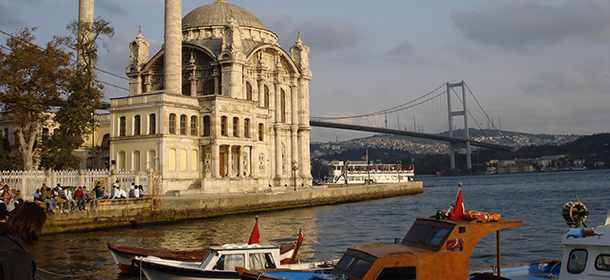OTTOMAN CAPITALS AND THE NORTH AEGEAN
Day 1 (Friday): Istanbul
Arrival in Istanbul, the only city founded on two continents; Europe and Asia. Orientation tour, and transfer to hotel. Evening at leisure. Overnight in Istanbul.
Day 2 (Saturday): Istanbul
Visit the Dolmabahce Palace, a masterpiece of the 19th century palaces in the Renaissance Style. Located on the Bosphorus, it is the second largest Ottoman Palace, and one of the richest palaces in the world. Proceed to Turkish and Islamic Arts Museum, where one glimpses the opulent life of the Ottoman upper class in the time of Suleyman the Magnificent. Highlights among the exhibits, date from the 8th and 9th centuries up to the 19th century. Visit the Hippodrome where chariot races and athletic events took place during the Roman Period, and the Blue Mosque, famous for its magnificently tiled interior. Later visit the Underground Cistern ( Yerebatan Sarayi),by far the largest of the many Underground Cisterns in the city remaining from Roman times, and the Museum of St. Sophia, a masterpiece of Byzantine architecture and one of the most extraordinary buildings in the history of architecture. Visit the Grand Bazaar, the old Ottoman shopping mall with 4,000 tiny shops. Evening at leisure. Overnight at the hotel in Istanbul. ( B ,L)
Day 3 (Sunday): Istanbul
After breakfast drive along the Golden Horn the historic neighborhood visit the Museum of St. Saviour of Chora, one of the most important monuments of Istanbul, with marvelous mosaics and frescoes representing scenes from the life of the Virgin and Christ. Next visit the Suleymaniye Mosque. Istanbul’s most important mosque is both a tribute to its architect, Sinan, and a fitting memorial to its founder, Suleyman the Magnificent. The mosque was not only a place of worship, but also a charitable foundation or Kulliye, and is surrounded by its former hospital, soup kitchen, schools, caravan serai and bathhouse. Explore the Topkapi Palace Museum, the great palace of the Ottoman Sultans, and enjoy the dazzling displays of treasures, the unique collection of Chinese, Japanese, Porcelains, and countless of artifacts. Then continue to the Archaeological Museum with a rich collection of classical antiquities including Roman statues, and one of the most beautiful sarcophaguses in the world, the Alexander the Great sarcophagus. We will see displays of antiquities from the Sumerian, Babylonian, Assyrian, Hatti and Hitite civilizations, and return to the hotel. Overnight in Istanbul . (B,L)
Day 4 (Monday): Edirne
We will have an early departure for Edirne, the second capital city of the Ottoman Empire on the border of Bulgaria. It is famous for its Ottoman buildings, and historic success in greased wrestling. Visit the Selimiye Mosque, one of the most famous Ottoman mosques, and also built by the architect, Sinan. We continue to visit Old Mosque built in 1414, the Three Galleried Mosque built between 1438-1447. The Sultan Beyazit II Complex was built between 1484 – 1488. This is one of the biggest welfare foundations of the Empire. We will see colorful Bazaars – Caravanserais. After lunch in Edirne, continue to Canakkale, and on route visit the WW1 bottle field ( The Gallipoli Peninsula ), the scene of one of the most notorious military campaigns of World War 1. We will visit the Anzac Cove, War Museum, Lone Pine Cemetery, Chunuk Bair (Conk Bayiri ). Afterwards we cross the Dardanelles strait to Canakkale Dinner and overnight in Canakkale. (B, D)
Day 5 (Tuesday): Canakkale – Troy – Assos – Ayvalik / Assos
Morning visit the legendary TROY, immortalized by Homer’s Illiad. This is the epic story of the war between Greeks and Trojans over beautiful Helen during the 1200 B.C. This was the first war between the Europe and Asia, lasting 10 years, and finally ending when Greeks invaded Troy using the famous wooden horse. Excavations have unearthed nine cities or settlement, dating from 3000 B.C to 400 A. D. Drive to Assos with a stop on the way to Alexandria Troas, an important city at the time of Lysimachos in 2 B.C., a place frequently visited by St. Paul. Assos is famed for its relation with Aristotle, the tutor of Alexander the Great. This ancient city went through the Lydian , Persian, Alexander the Great, Pergamum, Roman, Byzantine and Ottoman periods. Apostle Paul visited Assos on his missionary journey in 58 A.D. He met Luke and other companions in the city and they sailed to Lesbos. Dinner and Overnight in Assos / Ayvalik. (B,D)
Day 6 (Wednesday): Assos / Ayvalik – Pergamum – Sardis – Izmir (Symrna)
After breakfast drive to Pergamum along the mystical Agean coast. Pergamum was once was the rival city of Ephesus and the capital of the rich Pergamum Kingdom before the Roman Empire. It was an advanced city specializing in commerce, culture, art and medicine. Galen worked as a doctor in Pergamum’s healing center of Asclepion. Parchment was invented in Pergamum, which was home to the great Library of Pergamum. Visit the Aeropolis, the Altar of Zeus, the Temple of Trojan, Temple of Athena the Library and Asclopion. After lunch drive to Sardis (Via Akhisar-Thyatera). Sardis was founded was founded in the middle of the fertile valley of Gediz ( Hermus) in 1200 B. C. Sardis was the capital of strong rich Lydian Kingdom that had dominated much of the Aegean area before the Persians came (546C B.C.). The city continued to flourish during the Roman and the Byzantine periods. The ruins of Sardis spread over a large area. Visit The Gymnasium and Bath Complex the Synagogue, ancient shops, and the Temple of Artemis which was built by King Croesus of Lydia in 6C B.C. Continue to Izmir (Symrna) for Dinner and Overnight. (B,D)
Day 7 (Thursday): Izmir – Ephesus – Izmir=Istanbul
Morning orientation tour in Izmir, the third largest city of Turkey and the provincial capital of western Turkey. The city stands at a central position on the western coast of Asia Minor in the splendid Gulf of Izmir. Izmir (Symrna) was founded around 3000 B.C. by Trojan Yortan, (Indiginous Anatolians). It was the birthplace of Homer who wrote the Illiad. It was one of the most prosperous cities of Ottoman Empire, and is one of the seven Churches of Asia Minor mentioned in Revelation. Drive to Ephesus, home to St. Paul between 53 AD and 57 AD to visit the most impressive archeological site of today. The city, dedicated to Artemis, is the best-preserved archeological site in Turkey, and one of the most outstanding classical sites and tourist attractions in Turkey. During the Roman era, Ephesus was known worldwide as a city of trade, art, entertainment, banking and finance. An extremely a wealthy city, it was a dream city that everybody in the ancient world wanted to see at least once in his/her life. It was founded at the end of the old Silk Road , where the merchants from east and west used to meet. Ephesus reached its peak as the capital of the Roman Province of Asia Minor. Many different religions were practiced in Ephesus. You will truly feel you have traveled back in time, as you stroll along the 2000 years old marble streets, visit the Odeon ,the Gymnasium, the state Agora, the Marble Street where St. Paul walked and held daily discussions, the Selcius Library, The Temple Hadrian the Bath Complex, and the Great Theater. Visit the Temple of Artemis, one of the Seven Wonders of the ancient world, and in the afternoon visit the Ephesus Museum which houses many relics from Ephesus. We will see The Basilica of St. John and the tomb, where, according to tradition, St. John the divine was buried. Continue to visit the last home of the Virgin Mary. John brought the Virgin Mary to live here in peace in her final years. After full day excursion to Epheus and its environs late afternoon transfer back to Izmir Airport for a short flight to Istanbul.Overnight in Istanbul
Day 8 (Firday):Departure
After breakfast transfer to International Istanbul Ataturk Airport for the flight back to home


